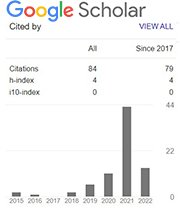“Kenapa Duniaku Begitu Melelahkan?”: Mengungkap Parental Burnout Ibu Rumah Tangga dengan Anak Autism Spectrum Disorder
Abstract
Keywords
Full Text:
PDF (Bahasa Indonesia)References
Agustina, D. (2023). Tega! ibu lempar anak autis dari balkon 2 kali, ini sebabnya.
Albintary, R., Rahmawati, H., & Tantiani, F. F. (2018). Dukungan sosial dan parenting self-efficacy pada orang tua anak autism spectrum disorder di Kota Blitar. JPPP - Jurnal Penelitian Dan Pengukuran Psikologi, 7(1), 46–52. https://doi.org/10.21009/jppp.071.06
APA. (2022). Diagnostic and statistical manual of mental disorders fifth edition text revision (DSM-5-TR).
Ardic, A. (2020). Relationship between parental burnout level and perceived social support levels of parents of children with autism spectrum disorder. International Journal of Educational Methodology, 6(3), 533–543. https://doi.org/10.12973/ijem.6.3.533
Astria, N., & Setyawan, I. (2020). Studi fenomenologi resiliensi ibu yang memiliki anak dengan autisme. Jurnal EMPATI, 9(1), 27–46. https://doi.org/10.14710/empati.2020.26918
Aunola, K., Sorkkila, M., & Tolvanen, A. (2020). Validity of the finnish version of the parental burnout assessment (PBA). Scandinavian Journal of Psychology, 61(5), 714–722. https://doi.org/10.1111/sjop.12654
Biggs, A., Brough, P., & Drummond, S. (2017). The handbook of stress and health: A guide to research and practice. (C. L. C. and J. C. Quick, Ed.), The Handbook ofStress and Health: A Guide to Research and Practice. John Wiley & Sons Ltd. https://doi.org/10.1002/9781118993811.ch21
Braun, V., & Clarke, V. (2006). Qualitative research in psychology using thematic analysis in psychology Using thematic analysis in psychology. Qualitative Research in Psychology, 3(2), 77–101. https://doi.org/10.1191/1478088706qp063oa
Creswell, J. W., & Poth, C. N. (2018). Qualitative inquiry & research design: Choosing among five approaches (4th ed.). SAGE Publications, Inc.
Fitriani, A., & Ambarini, T. K. (2016). Hubungan antara hardiness dengan tingkat stres pengasuhan pada ibu dengan anak autis. Jurnal Psikologi Klinis Dan Kesehatan Mental, 02(2), 34–40.
Hardi, N. F., & Sari, F. P. (2019). Parenting Stress Pada Ibu Yang Memiliki Anak Autis. Hisbah: Jurnal Bimbingan Konseling Dan Dakwah Islam, 16(1), 21–36. https://doi.org/10.14421/hisbah.2019.161-02
Herna. (2022). Pemanfaatan komunitas virtual dalam komunikasi pembangunan. Jurnal Inovasi Penelitian, 3(1). https://doi.org/10.47492/jip.v3i1.1640
Hsiao, Y. J. (2017). Parental stress in families of children with disabilities. Intervention in School and Clinic, 1–5. https://doi.org/10.1177/1053451217712956
Islami, E. D. P., & Ansyah, E. H. (2020). Self-acceptance of mothers who have children with special needs. Indonesian Journal of Cultural and Community Development, 7, 1–11. https://doi.org/10.21070/ijccd2020688
KemenPPPA. (2018). Hari peduli autisme sedunia: kenali gejalanya pahami keadaannya.
Kementerian Koordinator Bidang Pembangunan Manusia dan Kebudayaan RI. (2022). Bidang pembangunan manusia dan kebudayaan republik Indonesia. Siaran Pers Nomor: 16/HUMAS PMK/I/2022, (2021).
Kusdiyati, S., & Fahmi, I. (2020). Observasi psikologi. (N. N. Muliawati, Ed.). Bandung: PT. Remaja Rosadakarya Offset.
Magaldi, D., & Berler, M. (2020). Semi-structured interviews. In encyclopedia of personality and individual differences (p. pp 4825–4830). Springer, Cham. https://doi.org/10.1007/978-3-319-24612-3_857
Meeussen, L., & VanLaar, C. (2018). Feeling pressure to be a perfect mother relates to parental burnout and career ambitions. Frontiers in Psychology, 9(NOV). https://doi.org/10.3389/fpsyg.2018.02113
Mikolajczak, M., Brianda, M. E., Avalosse, H., & Roskam, I. (2018). Consequences of parental burnout: Its specific effect on child neglect and violence. Child Abuse and Neglect, 80, 134–145. https://doi.org/10.1016/j.chiabu.2018.03.025
Mikolajczak, M., & Roskam, I. (2020). Parental burnout: Moving the focus from children to parents. New directions for child and adolescent development, 2020(174), 7–13. https://doi.org/10.1002/cad.20376
Miranda, D. (2013). Strategi coping dan kelelahan emosional (emotional exhaustion) pada ibu yang memiliki anak berkebutuhan khusus. Psikoborneo: Jurnal Ilmiah Psikologi, 1(2), 64–71. https://doi.org/10.30872/psikoborneo.v1i2.3283
Nilawaty, C. (2021). Lebih dari 100 anak berkebutuhan khusus mengalami kekerasan selama Pandemi. Difabel.Tempo.Co, 1. https://difabel.tempo.co/read/1497233/lebih-dari-100-anak-berkebutuhan-khusus-mengalami-kekerasan-selama-pandemi
Nugraha, A. K. E. (2022, September). Psikolog nilai ibu bunuh 2 anak di Pinrang alami kelelahan psikis berat. Detik.Com, p. 1.
Papadopoulos, D. (2021). Mothers’ experiences and challenges raising a child with autism spectrum disorder: A qualitative study. Brain Sciences, 11(3), 1–16. https://doi.org/10.3390/brainsci11030309
Phetrasuwan, S., & Shandor Miles, M. (2009). Parenting Stress in mothers of children with autism spectrum disorders. Journal for Specialists in Pediatric Nursing, 14(3), 157–165. https://doi.org/10.1111/j.1744-6155.2009.00188.x
Roskam, I., Brianda, M. E., & Mikolajczak, M. (2018). A step forward in the conceptualization and measurement of parental burnout: The parental burnout assessment (PBA). Frontiers in Psychology, 9(758), 1–12. https://doi.org/10.3389/fpsyg.2018.00758
Sadziak, A., Wiliński, W., & Wieczorek, M. (2019). Parental burnout as a health determinant in mothers raising disabled children. Baltic Journal of Health and Physical Activity, 11(3), 77–89. https://doi.org/10.29359/BJHPA.11.3.08
Santrock, J. W. (2019). Life-span development. Life-span development, 7th ed. (17th ed.). McGraw-Hill Higher Education.
Savitri, L. N., Rakhmawati, W., & Sari, C. W. M. (2021). Gambaran perawatan diri anak remaja penyandang autism spectrum disorder di asrama. Jurnal Surya Muda, 3(2), 102–120. https://doi.org/10.38102/jsm.v3i2.85
Sekułowicz, M., Kwiatkowski, P., Manor-Binyamini, I., Boroń-Krupińska, K., & Cieślik, B. (2022). The effect of personality, disability, and family functioning on burnout among mothers of children with autism: A path analysis. International Journal of Environmental Research and Public Health, 19(3). https://doi.org/10.3390/ijerph19031187
SIMFONI-PPA. (2023). Ringkasan data kekerasan.
Swandari, D. N., & Mumpuniarti, M. (2019). Pembelajaran keterampilan sosial bagi remaja autis. Pembelajar: Jurnal Ilmu Pendidikan, Keguruan, Dan Pembelajaran, 3(1). https://doi.org/10.26858/pembelajar.v3i1.6066
DOI: https://doi.org/10.21107/personifikasi.v15i2.24014
Refbacks
- There are currently no refbacks.
Copyright (c) 2024 Ellyana Dwi Farisandy

This work is licensed under a Creative Commons Attribution 4.0 International License.


Personifikasi by Universitas Trunojoyo Madura is licensed under a Creative Commons Attribution 4.0 International License.










